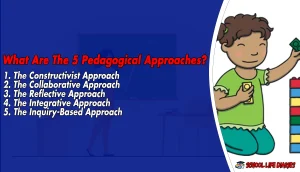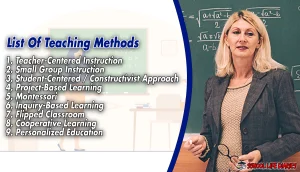Education is a crucial pillar of any society, and teaching approaches play a significant role in shaping future generations. The traditional teacher-centered approach has been replaced by modern student-focused teaching strategies that aim to enhance critical thinking and problem-solving skills.
With so many teaching methods available, it can be challenging for educators to determine the best approach to use. This article will explore the various pedagogical approaches used in education and provide insights into the most effective methods of teaching.
We will examine classroom and math teaching strategies and techniques that promote active learning, as well as discuss why teacher education is essential for effective instruction. We will delve into the key principles of an effective teaching approach that inspires students to take ownership of their learning journey.
What Are The 5 Pedagogical Approaches?
This discussion will explore five different pedagogical approaches to teaching. These approaches are the Constructivist Approach, the Collaborative Approach, the Reflective Approach, the Integrative Approach, and the Inquiry-Based Approach. Each approach has its own unique characteristics and can be used in different teaching settings to support student learning.
1. The Constructivist Approach:
The Constructivist Approach is a learning theory that emphasizes the importance of learners actively constructing their own knowledge and understanding through personal experiences and interactions with their environment. This approach focuses on the idea that students learn best when they are engaged in collaborative learning, experiential learning, and active engagement with their teachers and peers.
The role of the teacher in this approach is to act as a facilitator or guide rather than an authoritative figure. Student autonomy is also a crucial element of the constructivist approach. Learners are encouraged to take responsibility for their own learning by setting goals, evaluating progress, and reflecting on their experiences.
2. The Collaborative Approach:
Collaborative learning is a pedagogical strategy that emphasizes group work and the active participation of learners in the learning process. It is based on the idea that individuals learn best when they engage with others, share their ideas, and build knowledge together. Collaborative learning can take many forms, including team-based teaching, cooperative education, group-based instruction, and joint learning experiences.
In collaborative learning environments, students are encouraged to work together to complete tasks or solve problems. The teacher acts as a guide or facilitator rather than a lecturer or expert. This approach allows learners to develop skills such as communication, teamwork, and problem-solving while also building their content knowledge.
3. The Reflective Approach:
By engaging in reflective practices, learners can benefit from a deeper understanding of their own thought processes and biases. This approach involves examining one’s own experiences and actions to gain insight into how they affect learning outcomes.
By reflecting on past successes and failures, students can identify areas where they need improvement and develop strategies to overcome challenges. The reflective approach also encourages students to take responsibility for their own learning, rather than relying solely on the guidance of teachers or mentors.
4. The Integrative Approach:
Integrating various perspectives and knowledge domains is a fundamental aspect of the integrative approach. This teaching approach involves incorporating different subjects and learning experiences into a cohesive whole, allowing students to form connections between seemingly unrelated topics.
Multidisciplinary learning is at the core of the integrative approach, as teachers aim to provide a holistic education that goes beyond traditional subject boundaries. Cross-curricular teaching is one way in which the integrative approach can be implemented.
5. The Inquiry-Based Approach:
The inquiry-based approach prioritizes student-led questioning and exploration, emphasizing the development of critical thinking skills. This teaching approach encourages students to investigate a particular topic or problem by asking questions, gathering data, analyzing information, and drawing logical conclusions.
Inquiry-based learning is beneficial because it helps students develop a deep understanding of concepts and promotes active engagement in the learning process. To implement the inquiry-based approach successfully, teachers must provide clear guidance on how to conduct research and encourage collaboration among students.
What is Pedagogy?
Pedagogy, defined as the art and science of teaching, is a crucial aspect of education that plays a vital role in shaping students’ learning experiences. It encompasses a range of different theoretical foundations, learning theories, instructional techniques, curriculum design, and assessment strategies.
The aim of pedagogy is to help educators create effective learning environments that enable students to develop their knowledge and skills in meaningful ways. One important element of pedagogy is understanding the different learning theories that underpin educational practice.
These theories offer insights into how people learn and provide guidance on how teachers can structure their lessons to maximize student engagement and retention.
What Is the Best Method of Teaching?
One effective way to enhance the learning experience is to incorporate various teaching methods that cater to diverse student needs and preferences. Different teaching methods have their pros and cons, and it is essential to choose the most appropriate approach for a particular subject matter, level of complexity, and students’ learning styles.
One widely accepted teaching method is the lecture method, which involves a teacher delivering information through spoken words. The lecture method has several advantages, including providing students with a clear outline of the subject matter and offering an opportunity for teachers to explain complex ideas in detail.
Active learning promotes critical thinking skills while allowing students to apply theory to practical situations—however; it requires more preparation time on the teacher’s part than traditional lectures or presentations.
An interactive classroom environment where both educators and learners are involved in decision-making processes enables optimal knowledge assimilation retention while fostering creativity and innovative thinking among students.
List Of Teaching Methods
This discussion centers around five teaching methods:
– Teacher-centered instruction
– Small group instruction
– Student-centered/constructivist approach
– Project-based learning
– Montessori
Each method has its own unique characteristics and benefits for students. By exploring the key points of each method, educators can determine which approach is best suited for their classroom and individual learners.
1. Teacher-Centered Instruction:
Teacher-centered instruction is a traditional educational approach that places the teacher as the central figure in the classroom, responsible for imparting knowledge and directing learning activities. This type of instruction is often characterized by lecture-style teaching, where teachers stand at the front of the classroom and deliver information to students.
The focus is on teacher-directed learning, where students passively receive information from their instructor. One of the primary criticisms of teacher-centered instruction is its emphasis on rote memorization and knowledge transmission rather than critical thinking and problem-solving skills.
2. Small Group Instruction:
Small group instruction is a teaching method that involves breaking students into smaller groups to facilitate individualized learning and encourage collaboration amongst peers. This approach has been found to have numerous benefits, including increased student engagement, improved academic achievement, and enhanced social skills.
Small group instruction allows teachers to differentiate the curriculum based on the needs of each group and provide targeted support to struggling students while challenging high-achieving ones. To effectively implement small group instruction, teachers need to carefully plan and organize their lessons.
3. Student-Centered / Constructivist Approach:
Moving on from the previous subtopic, small group instruction, let us delve into a teaching approach that places more emphasis on student autonomy and active participation in the learning process. This is known as the Student-Centered / Constructivist Approach.
The Student-Centered / Constructivist Approach is based on the principle that learners construct their own knowledge through inquiry-based learning and active engagement with new concepts. In this approach, teachers act as facilitators rather than disseminators of knowledge.
They guide students toward finding answers to their own questions and creating meaning out of new information. Students are encouraged to take ownership of their learning by setting goals, reflecting on progress, and seeking feedback. Learning autonomy is highly valued in this approach as it empowers students to become independent thinkers who can apply what they have learned beyond the classroom setting.
4. Project-Based Learning:
Project-Based Learning is a hands-on approach to teaching that focuses on real-world applications. This method of instruction revolves around student-led projects that allow learners to explore topics in-depth and collaborate with peers to solve complex problems.
Project-based learning encourages students to take ownership of their education by giving them the freedom to choose how they will approach a given task, which can lead to increased engagement and motivation. In a project-based learning environment, students are challenged to use critical thinking skills and apply what they have learned in practical ways.
They work collaboratively on projects that require problem-solving, decision-making, and communication skills. By engaging in these activities, students develop not only content knowledge but also essential life skills such as teamwork, time management, and leadership.
5. Montessori:
Moving on from Project-Based Learning, another teaching approach that has gained popularity in recent years is the Montessori teaching method. This approach was developed by Dr. Maria Montessori, an Italian physician, and educator who believed that children learn best through hands-on experiences and individualized instruction.
At the core of the Montessori method is a child-centered approach to learning. Children are encouraged to explore their environment and learn at their own pace, with teachers acting as guides rather than lecturers. Sensory education is also emphasized, with materials designed to engage all five senses and promote independent discovery.
Overall, the Montessori teaching method aims to foster a love of learning in children by creating a supportive and engaging educational environment that allows them to develop into lifelong learners.
6. Inquiry-Based Learning:
Inquiry-Based Learning, a teaching method that emphasizes student-led exploration and discovery, encourages learners to ask questions and seek out answers through research and investigation. This approach focuses on the process of learning rather than just memorizing information.
It promotes critical thinking skills by guiding students to generate their own questions, analyze information, and draw conclusions based on evidence. One of the main benefits of inquiry-based learning is that it increases student engagement.
7. Flipped Classroom:
The Flipped Classroom model has gained popularity in recent years due to its potential benefits for student engagement and active learning. In this approach, students watch pre-recorded lectures or complete readings before class, freeing up valuable time for more interactive activities during class time.
This model allows students to take control of their learning experience by providing them with the opportunity to review material at their own pace and ask questions during class.
8. Cooperative Learning:
Cooperative Learning is a teaching strategy that involves students working together in small groups to achieve a common goal. This approach is based on the idea that learning is enhanced when students collaborate, share their ideas, and work towards a common objective.
When students engage in cooperative tasks, they experience positive group dynamics and develop skills such as effective communication and problem-solving. There are several benefits of using Cooperative Learning in the classroom. Firstly, it fosters learning communities where students feel supported and valued by their peers.
9. Personalized Education:
Personalized Education is a teaching approach that seeks to address the individual needs, interests, and abilities of each student by tailoring the learning experience to them. It involves a customized curriculum, adaptive instruction, and personalized assessment.
The goal is to empower students with autonomy over their own learning process and provide them with resources that cater to their unique strengths and weaknesses. In an era where traditional education has been criticized for its one-size-fits-all approach, Personalized Education offers an alternative that challenges this notion.
By placing greater emphasis on individualized learning, it recognizes that every student is different and therefore requires a tailored approach. This method promotes self-directed learning through customized instruction methods that adjust according to the student’s progress.
Classroom Teaching Strategies and Techniques
Effective classroom teaching strategies and techniques involve incorporating a variety of instructional methods to cater to the diverse learning needs of students. Student engagement is a key component of effective teaching, as it helps students stay focused and motivated throughout the lesson.
Active learning is one approach that promotes student engagement by encouraging them to participate in discussions, group activities, and problem-solving tasks. Differentiated instruction is another method that teachers use to accommodate different learning styles and abilities.
By providing multiple ways for students to learn content, teachers can help all students access and understand new information effectively. Assessment strategies are also important in promoting student achievement, as they help teachers monitor progress, provide feedback, and adjust their instruction accordingly.
Math Teaching Strategies and Techniques
Mathematics instruction can be enhanced by utilizing a variety of strategies and techniques to cater to the diverse learning needs of students. One effective strategy is problem-solving techniques, which allow students to develop critical thinking skills and apply mathematical concepts in real-world scenarios.
This approach encourages students to analyze problems, identify patterns, and develop logical solutions. Visual aids are also valuable tools in math instruction as they provide visual representations of abstract concepts that can be challenging for some learners. These aids include diagrams, graphs, charts, and models that can make complex mathematical ideas more accessible for students.
Furthermore, the use of visual aids helps teachers explain mathematical concepts effectively while keeping students engaged. Classroom management is another crucial aspect of math teaching strategies. Teachers employ various methods such as clear expectations, positive reinforcement, and student-centered learning to create a conducive learning environment.
By implementing effective classroom management techniques, teachers can maximize instructional time while ensuring that all learners have an opportunity to participate actively in lessons.
What Is The Importance of Teacher Student-Focused Teaching Strategies
One crucial aspect of quality education is the emphasis on student-centered teaching strategies that prioritize individual learning needs and foster active participation. In a student-focused classroom, teachers use differentiated instruction techniques to tailor their lessons to meet each student’s unique needs and abilities.
This approach increases student engagement by encouraging active participation, which empowers students to take ownership of their learning. When teachers employ strategies like project-based learning, cooperative group activities, and problem-solving exercises, they create opportunities for students to apply what they are learning in real-world situations.
These approaches allow students to work together collaboratively while also developing problem-solving skills that will benefit them in their future careers. By providing opportunities for students to engage with content in this way, they become more invested in their own education and interested in exploring new concepts.
When teachers implement student-focused teaching strategies that prioritize individualized learning and facilitate active participation, it creates an environment where students feel empowered intellectually.
What Are The Key Principles of An Effective Teaching Approach?
To cultivate a classroom environment that promotes active learning and student engagement, teachers must adhere to key principles of instruction. Effective implementation is crucial in ensuring that teaching strategies are properly executed and deliver the desired results.
This involves careful planning, organization, and delivery of lessons that cater to the diverse needs of students. Teachers must also adopt assessment methods that allow them to monitor progress and identify areas where improvement is needed. Creating an optimal learning environment requires teachers to be intentional in their approach to instruction.
They ought to create a safe space for students where they feel valued, respected, and free to express themselves without fear of judgment or ridicule. A positive learning environment encourages creativity, critical thinking, and problem-solving skills among learners.
To achieve this goal, teacher training programs should provide ample opportunities for educators to learn effective communication skills, classroom management techniques, and strategies for creating engaging lesson plans. An effective teaching approach must prioritize student engagement by making learning enjoyable and relevant.
Teachers can do this by incorporating interactive activities such as group work or games into their lessons or by using real-life scenarios that relate to the content being taught.
What Teaching Approaches Are Most Effective For Promoting Critical Thinking and Problem-Solving Skills?
Effective promotion of critical thinking and problem-solving skills in students can be achieved through the implementation of teaching methodologies that encourage active learning, real-world applications, and collaborative learning experiences. Several approaches have been identified as most effective for promoting these skills among students.
These include case-based learning, game-based learning, problem-based learning, contextual teaching, and experiential learning. Case-based learning involves presenting students with a real-world scenario or situation that requires them to analyze the information provided and come up with a solution or decision based on their understanding of the concepts involved.
This approach encourages critical thinking by requiring students to apply theoretical knowledge to practical situations. It also promotes problem-solving skills by allowing students to develop solutions independently while working collaboratively with peers. Game-based learning uses gaming elements such as rules, competition, and rewards to engage learners in an interactive experience that boosts their cognitive abilities.
This approach helps promote critical thinking by challenging students to think outside the box while solving problems presented during gameplay. Additionally, it fosters collaboration as learners work together towards achieving shared goals within the game environment.
Conclusion:
There are various pedagogical approaches that educators can utilize in teaching their students. Each approach has its unique strengths and limitations, and the best method of teaching ultimately depends on the learning objectives, student population, and context.
Some common teaching methods include:
– Lecture-based instruction
– Inquiry-based learning
– Cooperative learning
– Project-based learning
– Problem-based learning
Effective teaching approaches prioritize student-centeredness by creating a supportive and inclusive classroom environment that fosters active engagement and critical thinking.
Key principles of an effective teaching approach include clear communication of course content, assessment criteria aligned with learning objectives, feedback mechanisms that promote a growth mindset, and opportunities for reflection on the learning process.
The most effective approaches for promoting critical thinking and problem-solving skills involve active participation by students in exploring real-world problems through collaborative inquiry or experiential exercises.









